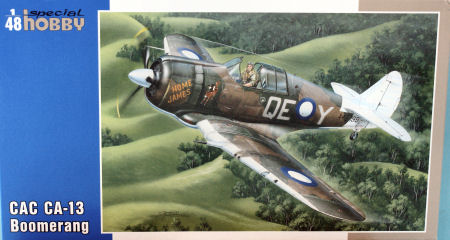
Special Hobby 1/48 CAC CA-13 Boomerang Kit First Look
By Michael Benolkin
| Date of Review | May 2011 | Manufacturer | Special Hobby |
|---|---|---|---|
| Subject | CAC CA-13 Boomerang | Scale | 1/48 |
| Kit Number | 48117 | Primary Media | Styrene, Resin, PE |
| Pros | Nice detailing inside and out | Cons | Nothing noted |
| Skill Level | Experienced | MSRP (USD) | $29.95 |
First Look
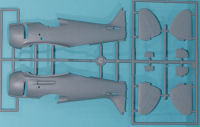 |
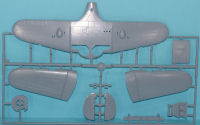 |
 |
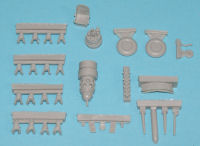 |
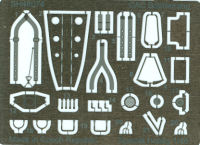 |
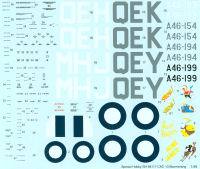 |
The Commonwealth Aircraft Corporation was the principal aircraft manufacturer in Australia in the years leading up to World War II. In the mid-1930s, the RAAF wanted an advanced trainer aircraft that could be license-built in Australia and the North American NA-16 was selected. The NA-16 design preceeded the T-6/SNJ as it was fabric covered, fixed gear, and had open cockpits. The designs CAC built included the fixed-gear version and a new retractable gear version that was also adopted into the T-6 design. This aircraft would be known in Australia as the Wirraway.
When war broke out in the Pacific, CAC was charged with developing an indigenous fighter aircraft to defend Australia should it be isolated from the Commonwealth by the expanding Japanese presence in the South Pacific. The logical choice was to adopt the Wirraway by shrinking it into a single-place aircraft, arming it with two 20mm cannons and four .303 Browning machine guns, and replacing the trainer engine with the R1830 Twin Wasp that powered the F4F Wildcat.
The first production block was designated CA-12 with 105 examples built. The second production block incorporated design improvements and these were designated CA-13. The final production block was a reconnaissance version designated CA-19. Development of more advanced versions was negated by the availability of US and UK aircraft as the war progressed. CA-12s and CA-13s served as home defense fighters in the early days of the war and was re-roled to a close air support aircraft later in the war with its great maneuverability, heavy weapons and good armor protection.
Special Hobby has turned out a nice new subject - the CAC Boomerang in 1/48 scale. What would a fighter variant of the T-6 Texan might have looked like? You're looking at it. This kit captures the lines of the aircraft quite nicely as well as the details.
Molded in gray styrene, this kit is presented on four parts trees plus one tree of clear parts, one bag of resin details, and one fret of photo-etched parts. What really surprised me was the price! I can't recall the last time I saw a multimedia kit like this for under $30 suggested retail price (MSRP)!
Like the full-scale subject, the kit is a simple build which naturally starts in the cockpit. One of the distinctive features of the North American T-6/SNJ series is the rugged tubular steel frame that runs from the firewall and surrounds the cockpit. CAC used the same design in their Wirraway and this followed into the Boomerang as well. Special Hobby replicates the tubular frame with separately molded parts independent of the airframe skin structure molded into the inside of the fuselage.
The cockpit side consoles are nicely detailed and the instrument panel is likewise nice with only the need for instrument faces to complete the appearance. The kit also has the mount for the horizontal compass used by Commonwealth aircraft during the war. The cockpit depth is also nicely captured with the raised seat mounts and foot trays over the cockpit floor (which is also the upper surface of the wing).
The Twin-Wasp is cast in resin and builds into a nicely detailed model of its own right. The engine has an accessory pack on its rear as well as exhaust stubs that flow into the exhaust collector ring, all of which should be visible through the open cowl flaps.
While the elevators, ailerons and flaps are all molded closed/neutral, the rudder is separately molded so you can position it as desired. With some careful surgery, the elevators can be repositioned as well to reflect the control lock released.
The wheel wells are nicely done and the rear of the engine can be seen through the open wheel wells just like an Fw 190D.
The kit has separately molded windshield and sliding canopy so you can position canopy open or closed. The cowl flaps are finely cast in resin and are only posed open, but this is typical anyway while the aircraft is on the ground.
Construction is completed with the addition of P-36-styled rear windows, resin 20mm gun fairings, exhaust diffuser, propeller and spinner.
Markings are provided for four examples:
- CA-13, A46-199, 4 Sqn, QE-Y, New Guinea, 1944, 'Home James'
- CA-13, A46-154, 83 Sqn, MH-J, Northern Territory, 1944, 'Wanda Lust'
- CA-13, A46-193, 4 Sqn, QE-H, Labuan, 1944, 'Struth!'
- CA-13, A46-194, 4 Sqn, QE-K, Labuan, 1944, 'The Grim Reaper'
The decals provide the distinctive and national markings as well as a complete set of maintenance stenciling for the airframe.
I really hope Special Hobby releases the CA-13 with the external tanks as well as the shorter airframe to render all three aircraft with either engine fit. Nonetheless, on the cool factor, we have this kit and it is a beauty. Sitting on the gear, you can almost hear that airframe still snapping and popping as it dissipates the heat build up from its latest test flight...







